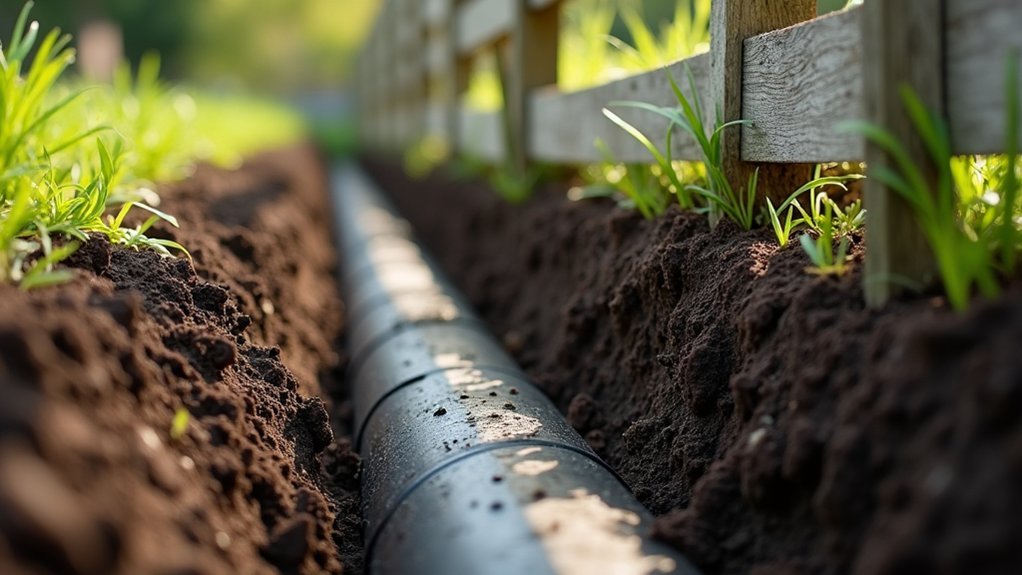To stop roots from damaging your fence, install deep root barriers (24-40 inches) before construction, choose trees with non-invasive root systems like Japanese maples or serviceberries, create mulched buffer zones with proper drainage, design flexible fence structures with elevated bases, and maintain a regular root pruning schedule during dormant seasons. These preventative measures will save you significant repair costs and extend the life of both your trees and fencing.
Install Deep Root Barriers Before Fence Construction

Prevention is the cornerstone of effective root management near fences. By installing deep root barriers before you construct your fence, you’ll redirect invasive roots downward and away from your structure, saving yourself costly repairs later.
Prevent root damage by installing barriers early—your fence and wallet will thank you later.
For ideal protection, install barriers that extend 24-40 inches deep along the fence line where roots pose the greatest threat. This depth effectively deflects horizontal root growth while encouraging deeper, healthier root systems for your trees. A properly installed barrier can trap and deflect problematic tree roots that would otherwise damage nearby structures.
The timing matters greatly—installation before planting or fence construction allows roots to establish natural growth patterns within the confines of the barrier.
This proactive approach also minimizes soil moisture competition between tree roots and fence foundations, preserving the structural integrity of both your fence and landscape elements for years to come.
Select Tree Species With Non-Invasive Root Systems
Choosing the right tree species stands as your best defense against root invasion near fences. Japanese Tree Lilacs and Serviceberries offer beauty with fibrous, controlled root systems that won’t threaten your fence line.
If you prefer maples, both Amur and Japanese varieties feature compact, slow-growing roots ideal for residential settings.
Consider trees with deep taproots like oaks or those with shallow but spread-out systems like pines, which are less likely to damage structures. Star Magnolias provide stunning blooms while keeping their roots in check.
The Kousa dogwood is another excellent option with pest resistant qualities and attractive clusters of white leaves that resemble flower petals in spring.
Always consult with an arborist before planting, as soil conditions and available space greatly influence root behavior.
Remember that proper selection now saves you from costly repairs later, while still allowing you to enjoy aesthetic and environmental benefits in your landscape.
Create Root-Friendly Soil Management Zones

Creating a root-friendly soil management zone near your fence provides a strategic approach to control unwanted root growth while maintaining plant health.
Start by testing soil EC levels and moisture conditions to understand your baseline.
Install vertical root barriers at least 30 inches deep to physically separate competing plants.
Create 3-4 foot mulched buffer zones around fences to suppress weeds and reduce competition.
For better drainage, apply coarse substrates in heavy soils and slope the ground away from fence lines.
Maintain soil pH between 6.0-6.5 and use slow-release fertilizers to prevent nutrient spikes.
Implement drip irrigation to deliver water directly to intended root zones without waste.
For areas with compaction issues, use a penetrometer to identify and address these zones that restrict healthy root development.
Monitor the electrical conductivity (EC) regularly, as this measures salinity levels that can significantly impact root health and nutrient uptake near fence lines.
Design Flexible Fence Structures for Root Accommodation
Flexible fence structures can markedly reduce conflicts between growing roots and your property boundaries. Choose modular panels with built-in gaps that allow roots to pass through without causing structural damage.
When installing your fence, consider elevating the base above typical root zones, creating space for natural growth patterns while maintaining boundary security. Custom fence solutions like FenceTrac System offer patented designs specifically engineered to accommodate landscape challenges.
- Use weather-resistant wire fencing with adjustable components that can be reconfigured as roots expand.
- Install fence sections with flexible hardware and fasteners that accommodate ground movement and prevent cracking.
- Plan your fence layout strategically by mapping underground root systems first and positioning posts away from major roots.
This approach means you’ll spend less time repairing fence damage and more time enjoying your outdoor space without harming established trees.
Implement Regular Root Pruning and Maintenance Schedule

Regular root pruning provides a critical defense against fence damage while preserving tree health. Establish a fixed maintenance schedule, ideally during dormant seasons when trees experience minimal shock.
Prune roots at a safe distance—maintain 6-8 inches away per inch of trunk diameter to avoid destabilizing the tree.
Use sharp, specialized tools like root cutting bars or rabbiting spades for clean cuts. For thicker roots, drill multiple holes or make several cuts to reduce strain. Always wear protective gear and clean your tools thoroughly. When confronting large roots wrapped around structures, a solid piece bar specifically designed for root cutting offers superior leverage and effectiveness.
Document your pruning dates and locations to track growth patterns. Combine root pruning with branch trimming to reduce growth stimulation.
After pruning, apply mulch near the tree base and consider installing root barriers to prevent future encroachment under your fence.
Frequently Asked Questions
Can Existing Mature Trees Be Treated for Aggressive Root Systems?
Yes, you can treat mature trees with aggressive roots through root pruning, barrier installation, growth regulator application, and soil aeration. Always consult an arborist first to avoid compromising tree health or stability.
How Do Chemical Root Inhibitors Compare to Physical Barriers?
Physical barriers provide immediate, long-lasting root blocking without chemicals, while chemical inhibitors require reapplication every 2-5 years. You’ll find physical options more effective but costlier upfront compared to chemical treatments.
Will Insurance Cover Fence Damage Caused by Neighbor’s Tree Roots?
Your insurance may cover fence damage from a neighbor’s tree roots, but only if it’s a covered peril. You’ll need to prove negligence for neighbor liability, so document everything and report immediately.
Are There Temporary Solutions During Property Sale Negotiations?
Yes, you can implement temporary fencing panels near disputed areas, install physical root barriers, perform targeted root pruning, and apply growth inhibitors while maintaining clear communication with buyers about these interim solutions during negotiations.
Can Root Barriers Damage Underground Utility Lines?
Yes, root barriers can damage utility lines if you’re not careful. They may puncture pipes during installation or redirect aggressive roots toward utilities. Always call 811 before digging and use flexible barriers near underground lines.
In Summary
You’ve now learned five proven strategies to prevent destructive root-fence conflicts in your landscape. By installing barriers, choosing appropriate trees, creating dedicated soil zones, designing adaptable fencing, and maintaining a regular pruning schedule, you’ll protect both your fence investment and tree health. Don’t wait until damage occurs—implement these techniques proactively. Your trees and fences can coexist peacefully with proper planning and ongoing care.





Leave a Reply